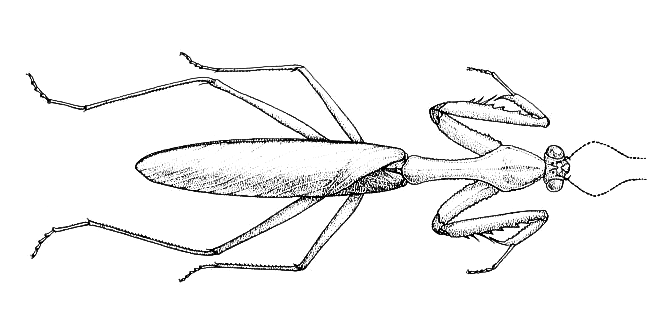|
Polyneoptera
The cohort Polyneoptera is a proposed taxonomic ranking for the Orthoptera (grasshoppers, crickets, etc.) and all other Neopteran insects believed to be more closely related to Orthoptera than to any other insect orders. These winged insects, now in the Paraneoptera, were formerly grouped as the Hemimetabola or Exopterygota on the grounds that they have no metamorphosis, the wings gradually developing externally throughout the nymphal stages. Taxonomy The ''Polyneoptera Species File'' lists the following: Superorder Dermapterida * † Protelytroptera Superorder Dictyoptera * Blattodea – cockroaches and termites * Mantodea – praying mantises Superorder Orthopterida Synonyms include: Archaeorthoptera, Gryllidea, Orthopterodea, Orthopterodida, Orthopteroidea, Panorthoptera * † Caloneurodea * † Geraroptera * Orthoptera – 2 extant suborders: ** Caelifera – grasshoppers, groundhoppers, pygmy mole-crickets ** Ensifera – crickets, mole-crickets, katyd ... [...More Info...] [...Related Items...] OR: [Wikipedia] [Google] [Baidu] |
Orthopterida
The cohort Polyneoptera is a proposed taxonomic ranking for the Orthoptera (grasshoppers, crickets, etc.) and all other Neopteran insects believed to be more closely related to Orthoptera than to any other insect orders. These winged insects, now in the Paraneoptera, were formerly grouped as the Hemimetabola or Exopterygota on the grounds that they have no metamorphosis, the wings gradually developing externally throughout the nymphal stages. Taxonomy The ''Polyneoptera Species File'' lists the following: Superorder Dermapterida * † Protelytroptera Superorder Dictyoptera * Blattodea – cockroaches and termites * Mantodea – praying mantises Superorder Orthopterida Synonyms include: Archaeorthoptera, Gryllidea, Orthopterodea, Orthopterodida, Orthopteroidea, Panorthoptera * †Caloneurodea * † Geraroptera * Orthoptera – 2 extant suborders: ** Caelifera – grasshoppers, groundhoppers, pygmy mole-crickets ** Ensifera – crickets, mole-crickets, katydids or ... [...More Info...] [...Related Items...] OR: [Wikipedia] [Google] [Baidu] |
Chresmodidae
Chresmodidae is an extinct family of Mesozoic insects within the superorder Polyneoptera. Genera *'' Chresmoda'' Late Jurassic-Cenomanian, Worldwide *'' Jurachresmoda'' Zhang, Ren & Shih, 2008 Middle Jurassic, Jiulongshan Formation *'' Sinochresmoda'' Zhang, Ren & Pang, 2008 Early Cretaceous, Yixian Formation '' Prochresmoda'' from the Triassic of Kyrgyzstan is not currently considered part of the group and is considered to be more closely related to '' Triassophasma'' and '' Palaeochresmoda''. Description ''Chresmodidae'' are large enigmatic insects with very long specialized legs, probably adapted for skating on the water surface, similar to extant water skaters. They can reach a size of about . and even . These Polyneoptera (partial syn Archaeorthoptera) of uncertain position have been considered aquatic, living on the water surface, probably predaceous on nektonic small animals.A. Nel, D. Azar, X. Martinez-Delclos and E. Makhoul A new Upper Cretaceous species of Chresmoda f ... [...More Info...] [...Related Items...] OR: [Wikipedia] [Google] [Baidu] |
Neoptera
Neoptera (Ancient Greek ''néos'' (“new”) + ''pterón'' (“wing”)) is a classification group that includes most orders of the winged insects, specifically those that can flex their wings over their abdomens. This is in contrast with the more basal orders of winged insects (the " Palaeoptera" assemblage), which are unable to flex their wings in this way. Classification The taxon Neoptera was proposed by А.М. Martynov in 1923 and 1924, in the following classification: Pterygota *division Palaeoptera **order Odonata **order Agnatha (correct name: Ephemeroptera) **†order Dictyoneuridea **†order Megasecoptera **†order Meganisoptera **†order Protephemeroidea *division Neoptera **superorder Endopterygota **subdivision Polyneoptera ***superorder Orthopteroidea (Anartioptera) ****order Orthoptera ****order Plecoptera ****order Dermaptera ****order Embioptera ****order Phasmatodea ***superorder Blattopteroidea (senior name: Pan dictyoptera) ****order Blattodea ... [...More Info...] [...Related Items...] OR: [Wikipedia] [Google] [Baidu] |
Dermaptera
Earwigs make up the insect order Dermaptera. With about 2,000 species in 12 families, they are one of the smaller insect orders. Earwigs have characteristic cerci, a pair of forcep-like pincers on their abdomen, and membranous wings folded underneath short, rarely used forewings, hence the scientific order name, "skin wings". Some groups are tiny parasites on mammals and lack the typical pincers. Earwigs are found on all continents except Antarctica. Earwigs are mostly nocturnal and often hide in small, moist crevices during the day, and are active at night, feeding on a wide variety of insects and plants. Damage to foliage, flowers, and various crops is commonly blamed on earwigs, especially the common earwig '' Forficula auricularia.'' Earwigs have five molts in the year before they become adults. Many earwig species display maternal care, which is uncommon among insects. Female earwigs may care for their eggs, and even after they have hatched as nymphs will continue t ... [...More Info...] [...Related Items...] OR: [Wikipedia] [Google] [Baidu] |
Embioptera
The order Embioptera, commonly known as webspinners or footspinners, are a small group of mostly tropical and subtropical insects, classified under the subclass Pterygota. The order has also been called Embiodea or Embiidina. More than 400 species in 11 families have been described, the oldest known fossils of the group being from the mid-Jurassic. Species are very similar in appearance, having long, flexible bodies, short legs, and only males having wings. Webspinners are gregarious, living subsocially in galleries of fine silk which they spin from glands on their forelegs. Members of these colonies are often related females and their offspring; adult males do not feed and die soon after mating. Males of some species have wings and are able to disperse, whereas the females remain near where they were hatched. Newly mated females may vacate the colony and found a new one nearby. Others may emerge to search for a new food source to which the galleries can be extended, but in g ... [...More Info...] [...Related Items...] OR: [Wikipedia] [Google] [Baidu] |
Plecoptera Plecoptera is an order of insects, commonly known as stoneflies. Some 3,500 species are described worldwide, with new species still being discovered. Stoneflies are found worldwide, except Antarctica. Stoneflies are believed to be one of the |



